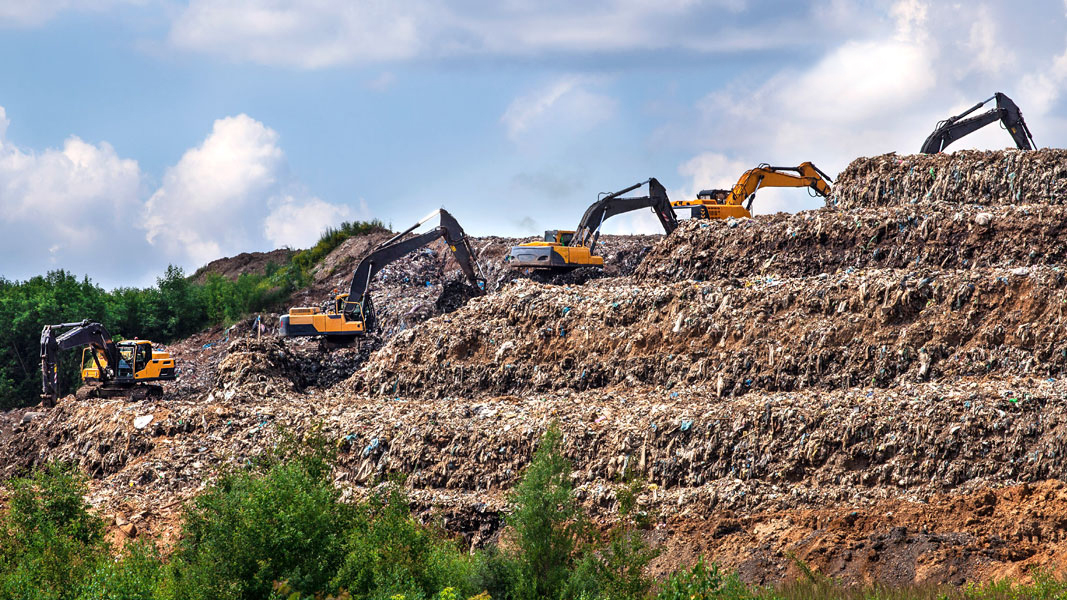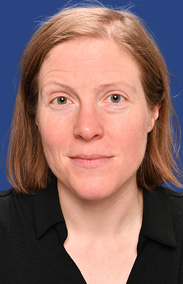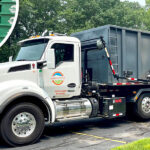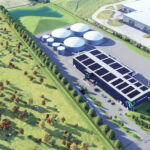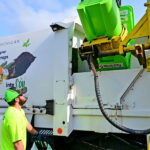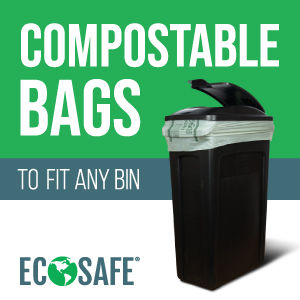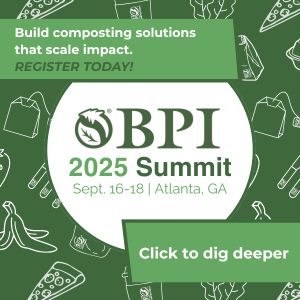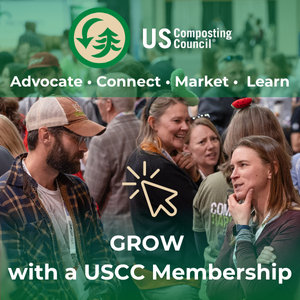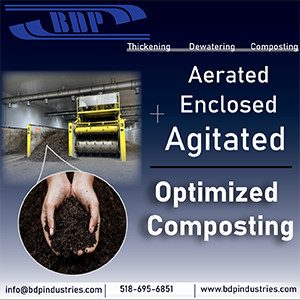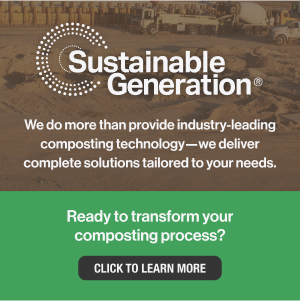Top: Full Circle Future is addressing emissions from the hundreds of millions of tons of waste already in landfills by raising the bar for how landfill operators find, capture, and control air emissions. Photos courtesy Industrious Labs
Nora Goldstein
A new advocacy organization, Full Circle Future, was launched in late July to “advance equitable solutions to one of the biggest climate and public health opportunities of our time — organic waste.” Originally a campaign of Industrious Labs, a group focused on transforming heavy industry, Full Circle Future partners with organizations, policymakers, coalitions, and communities to advance strategic and equitable solutions to big waste problems. “Landfills are literally out of sight, but for policymakers and advocates seeking solutions to our biggest problems, they should be top of mind,” explains Katherine Blauvelt, Executive Director of Full Circle Future. “The solutions are here — they’re proven, cost-effective, and ready to scale. With the right investments and smart leadership, we can make the air safer to breathe, save people money, create good-paying local jobs, and build a regenerative waste system that serves people. That’s the full circle future we’re committed to — and the momentum is only growing.”

From left to right, Full Circle Future is Elizabeth Schroeder, Karn Saetang, Lee Helfend, Katherine Blauvelt, Kim Finlay, Riikka Yliluoma.
In 2008, BioCycle and several other organizations launched COOL 2012, Compostable Organics Out of Landfills and Back To Soils. We set a goal to achieve this mission by 2012. The intent of COOL 2012 was sound, as was our commitment. What was lacking was the organized momentum at the local level to make COOL a reality. Now, Full Circle Future has taken up the torch, and BioCycle wanted to know more. We connected with Katherine Blauvelt, who has spent her entire career building coalitions, advancing solutions, and developing policies that improve peoples’ lives. Most recently, Blauvelt led the circular economy campaign at Industrious Labs — the team that has now spun off to become Full Circle Future. Through that work, she’s had her eyes opened to not only the scale of the organic waste crisis, but how much opportunity there is for real transformation.
What we learned is COOL now!
Full Circle Fundamentals
BioCycle: What factors played into Industrious Labs spinning off Full Circle Future as its own stand-alone organization?
Blauvelt: We’re proud of the work we were able to accomplish at Industrious Labs and hold all our colleagues there in the highest regard. Industrious Labs is laser-focused on transforming the heavy industrial sector to be a catalyst for climate, justice, and jobs. As the circular economy campaign grew, it became clear that the two entities had two distinct missions and areas of focus, and should be two separate organizations to enable both to dedicate their full capacity to the work they do best. We believe that organic waste is one of our most pressing, but solvable challenges, and are excited to continue building momentum as an independent organization.
BioCycle: Is the bulk of Full Circle Future’s work going to be focused on landfill methane emissions regulations and policies? Or will you be getting involved heavily in organics recycling initiatives?
Blauvelt: We firmly believe in a “full circle” approach to solutions — it’s actually a big part of where our name comes from! If your boat were sinking, you wouldn’t just bail out the water — you’d plug the hole. That’s our approach to organic waste: stop pollution at the source through policies like food recycling and food donation and address emissions from the hundreds of millions of tons of waste already in landfills by raising the bar for how landfill operators find, capture, and control air emissions.
BioCycle: You were quoted in an interview that Full Circle Future will be delivering “our data chops and our policy smarts to really just help supercharge existing efforts.” What sort of resources are you bringing to the organics recycling table?
Blauvelt: We have the rare privilege of having full-time, in-house research expertise (shoutout to our Director of Research and Analytics, Kim Finlay!). A core body of our work is focused on building publicly available tools and resources to spur policymaker action and make it easier for everyone to get involved. Our Waste Impact Tracker is a great example of how we work to turn hard data into power for communities. It allows users across all 50 states to explore landfill pollution at a state, county, or local level, while also understanding who lives nearby and what’s at stake.
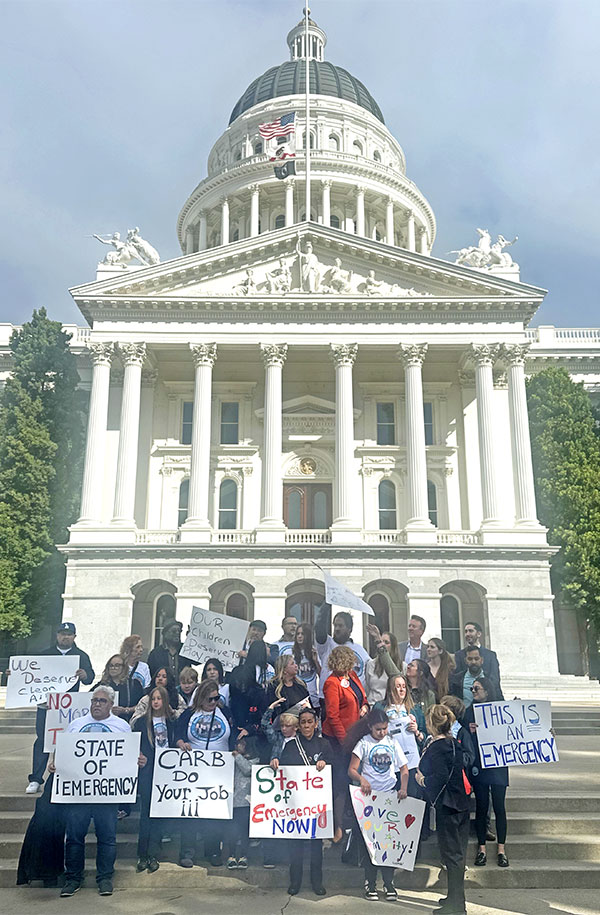
A core strategy is to invest in local leaders who know their communities best and can design approaches that are practical, equitable, and that work.
We believe in putting our research capacity where it’s most strategic and high-impact. For example, we’ve recently published resources on the disproportionate impacts of landfill pollution in Michigan, and the proximity of Colorado schools to landfills, as state policymakers are considering policies that could turn food waste into valuable soil amendments, and regulators are considering updates to the basic rules of the road to prevent harmful landfill emissions.
As part of Industrious Labs, we conducted first-of-its-kind research to put a spotlight on landfill pollution and model the large-scale emissions reductions that are achievable through practical and achievable organics recycling and landfill emission mitigation policies. We’re excited to continue this type of policy modeling in key states, and encourage everyone to keep an eye out for more original research later this year!
Carrots And Sticks
BioCycle: What, in your estimation, is needed to truly move the needle on diverting organics from disposal? Is it mandates or bans, technology improvement, economic incentives to households, businesses and industry to source separate? All of the above?
Blauvelt: In general, all of the above! But what excites us most is the incredible momentum we’re seeing across the country to prevent food waste and keep organics out of landfills. From small towns to big cities, community leaders are already showing what works, whether it’s food rescue, composting, or creative reuse programs.
We believe the most lasting solutions will come from listening to and investing in those local leaders. They know their communities best and can design approaches that are practical, equitable, and that work. Our role is to help clear barriers, secure resources, and amplify what’s already working so these solutions can spread and scale.
BioCycle: As a follow up, where is it most effective to begin?
Blauvelt: A good starting point is with solutions that are already working — like the food scrap diversion policies in Maryland, thanks to the Institute for Local Self-Reliance (ILSR) and Clean Water Action Maryland, and many others. Full Circle Future will support them with resources and next-generation policies that track success, so we can scale what works and truly fix this problem in our lifetime.
BioCycle: From a landfill methane emissions control standpoint, do you see a scenario where keeping food waste out of the landfill actually makes sense for landfill operators?
Blauvelt: The reality is that the current system is stacked in favor of landfill operators. Republic Services, a multi-billion-dollar waste company, literally wrote in their 10-K filing to the Security and Exchange Commission that recycling and composting could cause their revenues to decline. Every truckload of trash that goes into the 2,600+ landfills in this country generates big bucks while the public bears the costs of wasted resources, climate, health, and community impacts. Right now, landfill operators profit while families and communities pay the true cost of wasted resources.
The system we have today — how trash is collected, sent to landfills, or burned — is the result of decades of policy choices, regulations, and incentives that shaped who profits. Because laws and rules created it, it can be changed by new policies and smarter regulations that prioritize communities, the climate, and waste reduction. For example, policymakers in the state of Washington, thanks to efforts of groups like Zero Waste Washington, are investing in food waste prevention, food rescue, and organics management facilities that will create local jobs and benefits for communities.
Tackling Headwinds
BioCycle: The biogas industry is loving landfill methane capture for renewable natural gas (RNG). What are downsides, if any?
Blauvelt: We take a bit of a cautious approach to waste-to-energy projects. The reality is that the rules governing these systems are full of holes. Operators face no real penalties for fugitive methane leaks, so while they profit from generating energy, the public pays the price in the form of unchecked methane and other harmful emissions. There are no guardrails to prevent unintended consequences.
Another problem with putting too many eggs into the waste-to-energy basket is that it creates financial incentives that perpetuate our current harmful take-make-waste system. Very simply put, you can’t turn waste into energy without a lot of waste, and landfilling food is a terrible waste of precious resources and money. Providing financial incentives to continue landfilling waste doesn’t solve our methane problem and can come at the expense of solutions that deliver many more jobs and economic benefits for communities, like local composting or feeding animals (check out GAIA’s report on job potential).
We have also seen substantial unchecked methane emissions at landfills with biomethane infrastructure. In an analysis we did of dozens of U.S. EPA inspections of landfills across the country, we found that most of the facilities that had landfill-gas-to-energy systems identified in the Inspection Reports experienced methane exceedances. For example, a U.S. EPA inspection of Atascocita Landfill in Texas found 75 methane exceedances, measuring as high as 18,000 ppm (the federal limit is 500 ppm!). Capturing methane for energy doesn’t fix poor landfill covers, weak monitoring for leaks, or the fundamental reality that regulations are Swiss cheese.
BioCycle: What are key alliances to foster — and are there any models that have worked for other campaigns, e.g., you need to start with getting “X” on board?
Blauvelt: We know that transforming our waste industry is a big undertaking, and it’s going to require building a very big and very diverse tent. We welcome anyone to the table who’s excited about building a more sustainable waste infrastructure that works for all.
In the near term, one of our biggest priorities is convening a national working group of people directly impacted by landfill pollution. We are working with folks in rural communities, big cities, small towns, and everything in between — there are landfills in every state across the country. Again, these are folks who have been sounding the alarm on landfill pollution for decades, and who have been largely ignored by those in positions of power.
But we’ve also seen what’s possible when communities bring forward solutions. Just this past June, our partners at VNEQS, residents living near the Republic Services-owned Coffin Butte Landfill and experiencing its harmful impacts, and Beyond Toxics Oregon achieved a major victory when Governor Tina Kotek signed Senate Bill 726 into law, requiring the Coffin Butte landfill to use drones, satellite information, or other effective technologies to detect methane leaks. This came after years of community-led organizing, backed by research and data. This isn’t just a one-off win: it’s a playbook for how people can drive real change.
BioCycle: A significant challenge, historically, to advancing organics recycling has been “imbedded” infrastructure financed with bonds by public agencies and waste authorities. This has created a serious disincentive at the local level to adopt infrastructure like composting. Is this just something organics recyclers have to wait out, until that infrastructure is paid off or breaks down?
Blauvelt: It’s true that rigid contracts and misguided investments of tax dollars in existing landfills and burners have created real barriers to shifting towards more community-oriented solutions. But communities shouldn’t have to wait for these facilities to crumble or burn to the ground (yes that happens) for their elected officials to make choices that actually create good for the community. The reality is that landfills and incinerators are already costing the public far more than they return — in health impacts, wasted resources, wasted food and climate pollution. And let’s not forget that the waste industry is a multi-billion dollar industry, raking in profits for large corporations.
There are real-world examples of how communities are moving past these barriers right now. In Maryland, for instance, state policymakers expanded on-farm food scrap composting. This reform, shaped by farmers, environmental groups like ILSR and Clean Water Action Maryland, and local composters, doubled the area allowed for on-farm composting, cutting red tape and making it easier for local farms to recycle food scraps. It shows how policy can unlock new recycling infrastructure that creates a host of local wins: farmers get a new source of revenue, the community avoids more harmful waste, and healthy soil amendments are created.
We know that food recycling and food waste prevention are proven, job-creating solutions — and with the right support, they can scale now.
BioCycle: In your opinion — and honestly, I’m looking for some reassurance — how much ground are we losing under this Administration when it comes to advances in fighting climate change? Are states and local governments still marching forward?
Our team actually brings a lot of optimism to this work. We continue to see real momentum — and real policy change opportunity — even in today’s challenging political climate. Cities and states are leading the way with new policies and programs to strengthen landfill standards and divert organic waste. For example, Colorado air regulators are just days away from voting on the strongest landfill methane standards in the country. Our coalition in Michigan is working to bring composting programs to Detroit public schools. These are wins that communities can see and feel — and that makes them politically viable and scalable.
This is also an issue where we’ve seen support and excitement from across the political spectrum. In Congress, we regularly see bipartisan recycling legislation, like the recently introduced, bipartisan CIRCLE Act that invests in recycling infrastructure. Nobody likes trash, regardless of who they voted for or what party is listed on their voter registration. Nobody wants the landfill in their community to catch on fire. I can’t imagine anyone being in favor of throwing away billions of dollars a year in wasted food, or who wants to breathe in benzene from a landfill in their backyard. Everyone can get on board with local jobs, healthier soil, clean water, and making sure kids have enough to eat.


